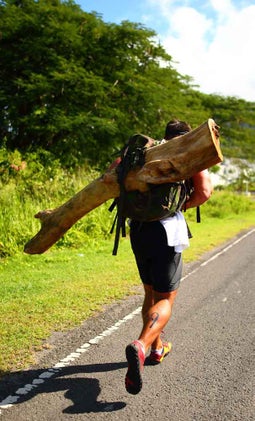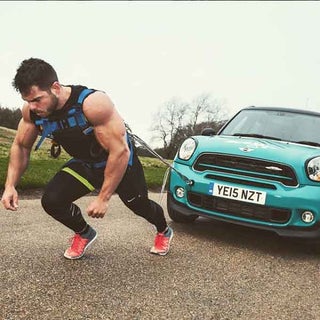New perk! Get after it with local recommendations just for you. Discover nearby events, routes out your door, and hidden gems when you sign up for the Local Running Drop.
Chances are Ross Edgley’s first triathlon was harder than yours. The 32-year-old from Grantham, England, has a knack for taking on daunting fitness challenges then finding bizarre ways to make them even tougher. He ran a marathon while towing a 3,000-pound MINI Countryman, which took more than 19 hours to complete. He once spent nearly 24 hours climbing a rope until his vertical gain totaled 29,029 feet, the height of Mt. Everest. For his first triathlon, on the Caribbean island of Nevis, Edgley opted to do it with a 100-pound tree trunk strapped to his back.
“It’s an odd concept I know,” says Edgley about racing with a tree. “First and foremost, it was a means to promote Nevis’ pioneering eco-friendly ambitions. Secondly, I have to admit that the athlete in me just wanted to see if I could condition my body to do it.”
To understand how Ross Edgley became Treeathlete Ross Edgley, you have to take a leap back in time to Grantham, a small city in central England about 100 miles north of London where he was born and raised.
Sports came naturally to him, and as the middle of three brothers, so did competition. “My brothers were my training partners and rivals growing up,” he says. “There’s literally nothing we wouldn’t compete at.” While he excelled at everything from tennis to soccer, it was in the water where Edgley found his true calling, and by age 13 he found himself competing on the British junior national water polo squad. One year later, his coaches decided he was ready to play with the senior national team, and that call up is ultimately what led him to becoming the athletic super-freak he is today.
While Ross was already very strong and physically advanced for a 14-year-old, competing with grown men in a sport as aggressive as water polo was a huge wake-up call. “I remember one match in particular against the national team from Malta,” he says. “I took an absolute beating at the hands of this bear-like man with a giant beard and vice-like grip. We got into a fight and he held me underwater for what seemed like an eternity. Just before passing out, I took a bite out of his calf so that he’d let go. It’s something I’m not proud of, but it was the only thing I could do. It was at that point that my coach and I realized we needed to refine my training if I was going to have any longevity in the sport.”
True to his nature, Edgley’s commitment to training consumed him, and a few years after that calf-biting incident, he found himself enrolled at Loughborough University’s School of Sport and Exercise Science. He also found himself with 40 extra pounds of muscle on his frame, thanks to countless hours at Loughborough’s gym and an obsessive drive to learn all he could about various training methods and techniques.
While most who look at Edgley’s extraordinary physique label him a “bodybuilder,” he’s quick to point out that he’s never trained for or competed in any form of bodybuilding. Yes, he has a genetic predisposition for building massive muscles. And yes, he could probably win a lot of bodybuilding competitions. But Edgley’s paramount philosophy when it comes to training is all about building functional muscle so that he can use his body as an apparatus for accomplishing remarkable feats of strength and endurance. Like lugging a 100-pound tree trunk through an Olympic-distance tri.
Edgley’s training methods have evolved throughout the years as he’s learned more about his own physiology, and in accordance with whatever insane undertaking he’s currently preparing for. But whether he’s trying to tow a car for 19 hours, climb up a rope until he literally loses all the skin on his hands, or strap a tree to his back and race a triathlon, his focus on “adaptation energy” remains his guiding principle. Regarding training, this concept of adaptation energy is something uniquely Edgley. He seeks to ensure that his body’s energy reserves are always high enough that he can apply enough training stress to produce the adaptations he desires.
The basis of this ideology is making sure his body is always ready to respond to training stress so that he can go all out every day, or at least as close to 365 days per year as his body will allow. Periodization does not exist in Edgley’s world. “This idea of adaptation energy can be accurately measured with a few simple blood tests, but relying on men in white coats to tell you how to train every day isn’t practical for most people,” he says. The most common marker used in oxygen saturation, or SpO2, which is a measure of how much oxygen your blood is carrying on a scale of 0-100. A reading below 95 may indicate you’re on your way to overtraining. “Instead, become your own expert and listen to your body. Although your program might say you have a 10-mile run, don’t feel like you have to do it if your adaptation energy is low.” In other words, if you don’t feel like you can nail that 10-mile run hard enough to produce a positive adaptation, don’t do it.
Edgley is currently training for a stunt he’s deemed the “Strongman Swim,” which is a total of 100K of swimming over the course of four giant open-water swims, all while towing a log similar in size to the one he used for the “treeathlon” in Nevis.
One look at his weekly training plan and it’s clear that his adaptation energy is never very low. The final segment of the Strongman Swim will be a 40K jaunt from Martinique to St. Lucia in the Caribbean Sea. If he completes it, he’ll be the first person in the world to do that crossing— with or without a tree in tow. To prepare, Edgley has been swimming up to 100K per week, including a 20K session in the pool each Sunday that is usually made up of 100 200-meter repeats at the fastest interval he can sustain.
If 100K per week in the pool seems insane, consider that it only accounts for about half of Edgley’s weekly training volume. There’s also at least 30K of running, a couple of bike rides, and, of course, a good hour and a half of gym work every day.
While such ridiculous volume would give most athletes the physique of an East African marathoner, Edgley’s mastery of nutrition has enabled him to maintain and even build functional muscle while training more than 30 hours per week.
 He boasts that he can consume up to 15,000 calories a day when his workouts call for it, but an average day of eating is about 8,000 calories. He’s particular about his numbers and estimates that his diet is roughly 62 percent carbohydrates (or about 1,240 grams per day on average), 27 percent fat (240 grams) and 11 percent protein (220 grams). The science nerd in him settled on those percentages after years of poring over research published in the Journal of Sports Nutrition.
He boasts that he can consume up to 15,000 calories a day when his workouts call for it, but an average day of eating is about 8,000 calories. He’s particular about his numbers and estimates that his diet is roughly 62 percent carbohydrates (or about 1,240 grams per day on average), 27 percent fat (240 grams) and 11 percent protein (220 grams). The science nerd in him settled on those percentages after years of poring over research published in the Journal of Sports Nutrition.
To jam in such a massive amount of calories, Edgley has found ways to make his favorite foods as nutrient-dense as possible. That includes things like loaded oatmeal with blueberries, flaxseeds, vegan protein powder, cacao nibs, and peanut butter. There’s also his favorite post-workout recovery snack of “chocolate protein cheesecake” that includes everything from yogurt, muesli, coconut oil, berries and whey protein. (See the recipe below.)
Unable to find sports nutrition products on the market that would help him push himself to the preposterous levels he desired, Edgley co-founded one of Europe’s largest sports nutrition brands, The Protein Works, which makes high-end pre- and post-workout supplements, as well as baked goods like protein cookies and brownies. “I’m constantly in the lab with the sports scientists trying new pre- workouts, proteins, recovery formulas, and anything else we can come up with,” he says. “I’m basically like a human guinea pig fueled by this insatiable curiosity to understand how the human body works.” While he prefers to get as many of his calories as possible from real food, omega-3, vitamin D, and creatine have long been his three staple supplements. “Those three in particular are backed by so much research that they should feature in every athlete’s diet,” he says.
Edgley already has the first three legs of the Strongman Swim out of the way. All that’s left is his record-breaking Caribbean crossing in November. Once that’s behind him, the man who never seems to sit still admits that he’ll allow himself 10 days of R & R in St. Lucia before heading back to the U.K. to sit down with friends and family and plan what crazy stunts he’ll attempt in 2018. “We have at least 20 crazy ideas already,” he says. “I’ll speak to my charity partners and just pluck one out of the mix. Whatever it is, it has to be bigger and better to continue raising the bar.”
One idea that’s been gaining momentum as of late: An iron-distance treeathlon.
“I’ve always said I’d like to do an Ironman with the tree,” he adds. “Not just to finish it, but to do it in a legitimately good time too.”
Crazy for a Cause
There’s meaning to the madness behind Edgley’s seemingly psychotic endurance endeavors. Each one is carefully planned to raise money or awareness for causes he feels passionate about. His marathon and rope-climbing stunts raised thousands of dollars for the Teenage Cancer Trust and spent nearly
an entire day trending on Twitter in the U.K. As for why he’d attempt to finish an Olympic-distance triathlon accompanied by a massive piece of driftwood? Edgley, a passionate environmentalist, wanted to raise awareness of Nevis’ commitment to become the world’s first carbon-neutral island by 2020 so other places around the world would take notice and follow suit.
Log-gistics
Edgley’s swims and tri have each featured different wood. Here’s how trees become contenders:
1. It must be special to that area. “In England you might get an oak tree, but Caribbean something more tropical,” he says. On the Caribbean island of Nevis, where he raced his treeathlon, news spread quickly that he needed a 100-pound tree. “We had people from all over the island looking for one for me,” he says. “We had so many trees to choose from in the end, but I just gravitated to this oddly shaped one—it just had character. It had been blown down in the hurricane just weeks before and I just felt it had some fight left in him and one last adventure.”
2. Fallen trees are first pick. If he takes one, he replants one.
3. It’s gotta have heft. The log makes its official weight dry. “But it’s always heavier when I get it out of the swim and onto the bike,” Edgley says. “What I finish the swim with is not the same log as I started with as it soaks up water.”
Home Schooled
Wisdom Edgley gained from being his own guinea pig
Stunt #1: The Tree-Athlon
Lesson Learned: Love the carbs and fats
“One thing that I loved about the tree-athlon was that it allowed me to experiment and explore new nutritional protocols. Most traditional nutritionists would argue that carbs are the body’s primary fuel source, and for many sports that’s true. But recent research has shown that the energy needed to sustain exercise for a long period of time needs to come from two fuels—carbohydrates and fats. When I stepped onto the start line in Nevis I had a dual-fuel approach to nutrition. Did it work? Well it allowed me to train up to 12 hours a day and fueled every mile of the world’s first tree-athlon.”
His race day regimen:
Breakfast: Banana and peanut butter protein pancakes
During the race: A carb/electrolyte blend from his company’s lab
Recovery: Meat, veggies, and more carbs to replenish muscle glycogen
 Stunt #2: Pulling a Mini Cooper for 26.2 Miles
Stunt #2: Pulling a Mini Cooper for 26.2 Miles
Lesson Learned: A little extra can go a long way
“I could only manage to pull the car for one mile when I first tried. My ligaments, tendons, and immune system all wondered ‘what are you doing?’ So I had to develop this horse-like work capacity. Work capacity can be defined as the total amount of training the body can perform and then positively recover and adapt to. The three ways I increased my work capacity—to the point I could pull a car for an entire marathon—was to add more sets to my workouts, add supplementary cardio, and add ‘finishers.’ The first two are self-explanatory. ‘Finishers’ are quick, intense, movement-specific exercises you can add to the end of your workouts to ‘finish’ your muscles. Examples could include sled sprints after a big leg session, rope climb repeats after a huge arm workout, or tire flips after a colossal dead lift.”
Stunt #3: Climbing a Rope to the Top of Everest
Lesson Learned: Technique is everything
“You can only get by on athleticism, strength and stamina for so long. You need efficiency to keep going. All movements have what’s known as a kinetic chain—how all your joints and movements work together during certain movements. Without it, your legs and core fail to work in unison with your arms and your biceps are forced to battle gravity on their own. During a 24-hour rope climb you need one incredibly efficient kinetic chain. It’s worth noting that there are many ways to climb a rope—from the Navy Seal-inspired methods to CrossFit and Marine techniques. The key is to find what technique works with your individual physiology and then become incredibly efficient in it. For me this was the Marine-style brake technique. I found that it wasn’t the quickest, but it was the most efficient in terms of energy expenditure and sustaining my technique for 24 hours.”
Ross’s Recipe: Chocolate Protein Cheesecake
Makes 6 Servings
Ingredients
Filling
• 17 ounces quark, a creamy cheese
• 8 ounces natural yogurt
• 4 T whey protein
• 3 tsps cocoa
• 2 tsps vanilla extract
• 2 egg whites
• 1 packet of gelatin (optional but helps create a thicker texture)
• 1⁄4 cup blueberries
• 1⁄4 cup strawberries
• 1 cup milk
Crust
• 1 cup muesli
• 2 tsp honey
• 1 tsp coconut oil (nut butter is optional)
Directions
Filling
1. Put the gelatin into water
2. Mix milk and cocoa, add gelatine 3. In bowl mix yogurt and quark
4. Add milk, vanilla, and cocoa to quark
5. In separate bowl, whisk eggs
6. Slowly fold eggs whites into quark mixture
Crust
1. Heat coconut oil and honey until melted
2. Stir in oats until fully coated with oil and honey
3. Place in springform tin and gentlly press mixture into place
4. When cooled, spread topping mixture over gently, careful not to mix the two
5. Place in fridge for at least four hours
Nutritional Information (Approximate, per serving)
• 438 calories
• 23g protein
• 74g carbohydrates
• 7g fat
Update: Edgley fell just short of his Caribbean goal. He made the attempt twice and totaled up over 100K of swimming, but technically wasn’t able to touch the shore due to water conditions. See his posts below.
[twitter url=”https://twitter.com/RossEdgley/status/929666219250241536″ align=”center”]
[twitter url=”https://twitter.com/RossEdgley/status/933061676513071105″ align=”center”]
Editor’s note: The article originally appeared in the November 2017 issue of Triathlete magazine. To keep up on Edgley’s latest adventures, follow him at @RossEdgley.
